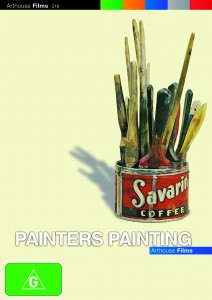Director Emile de Antonio made his reputation with a number of documentaries on political subjects. Point of Order [1964] was a powerful indictment of the political paranoia let reign in the US in the 1950s and early ‘60s. Subsequent documentaries on the assassination of John F. Kennedy, the presidency of Richard Nixon and other politically ‘hot’ subjects established Antonio as both an activist and a hard hitting director. So in 1973 when de Antonio trained his cameras on the art world one might have expected some sort of expose. Instead Painters Painting is a thoughtful, sometimes amusing history of the New York art scene from the 1940s until the 1970s.
As a historical document of its times Painters Painting is an incredible resource. Among the artists interviewed are Barnett Newman, Willem de Kooning, Robert Motherwell, Robert Rauschenberg, Andy Warhol, Frank Stella and many others [with one lone woman artist in Helen Frankenthaler being asked the single question, what it’s like to be a female painter? “The first thing is to be a painter,” she asks with visible resignation]. Around the artists are interviews with dealers such as Leo Castelli, critics including Clement Greenberg and Hilton Kramer, and various museum curators such as William Rubin and Henry Geldzahler.
Much like the approach of his previous documentaries, de Antonio set up the camera and lets the artists talk at length. Compared to the pace of contemporary documentaries, Painters Painting seems to last as long as it would take one of Newman’s canvases to dry, and the artists have plenty to say. Its remarkable to hear the artists and critics alike talk about the New York art scene in the post war period as a provincial backwater and the emergence of abstraction and abstract expressionism – and then on to colour field, pop art and the rest – as articulations of an American reaction to European painting – “The New York School was a mopping-up operation for the School of Paris,” opines Kramer. It is only as the 1960s begins do the New York artists begin to have the arrogant confidence ascribed to American art of the period – a smirking but very funny Robert Rauschenberg is interviewed atop a high step ladder, Jasper Johns rambles while slightly drunk in his studio as Bob Dylan records play loudly in the background.
Alternating between black and white footage for the interviews and colour for the roaming images of art, Painters Painting has an oddly static feel. But the revelation of artists like Newman and his peers as fusty old guys in cardigans, drinking scotch and smoking, talking the big talk about painting [“A painter is a choreographer of space…”] is just one remarkable aspect of this doco. Another is how the social context of the art making changed so dramatically over those three decades. Newman and de Kooning discuss how their art practice was almost entirely studio bound, with rare outings for openings, but otherwise it was a solitary, often lonely existence. But by the time the younger generation rolled in – Johns, Rauschenberg, Warhol – the art scene had become the art world. Greenberg sums up Warhol’s work as “scene art” the scene being “the place where you put yourself” – the often glamorous but not-serious world of the younger generation. Warhol himself denies actually painting anymore, with Brigid Berlin at his side claiming to do all the work, and answering most of Andy’s questions.
Although clocking in at nearly 2 hours and snail-paced in parts, Painters Painting can justifiably lay claim to being one of the key documentaries on American art making of the post war period.
Painters Painting
Dir: Emile de Antonio
Runtime: 116 mins.
Arthouse Films/Madman

